We may earn revenue from the products available on this page and participate in affiliate programs. Learn More ›
Refresh These Passé Features

Some home design features from the past have a charm that makes them feel historic or vintage. Others? They haven’t quite stood the test of time. A trend that was so ubiquitous in one particular decade that it instantly dates your home can be an instant giveaway that you haven’t renovated in decades. Of course, you may not care if your home is on trend. If you absolutely love a quirky feature, by all means keep it. If you’re making changes to your home with resale value in mind, however, consider updating these old-school features.
Carpet Everywhere
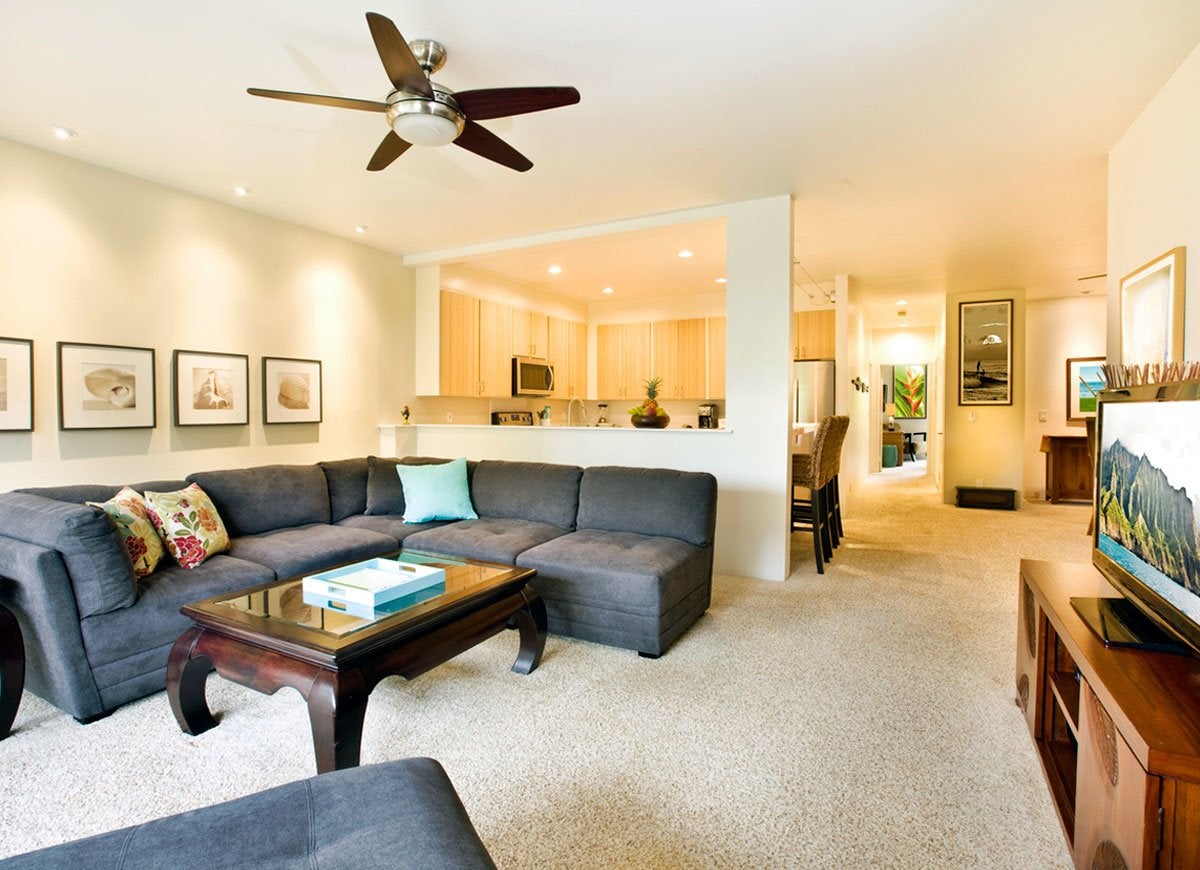
There was a time when wall-to-wall carpeting was a luxurious must-have, but these days it’s all about hardwood. Although carpeting adds comfort underfoot and absorbs sound—which is especially important in bedrooms—consider upgrading to wood on the main floor of your home. Not only is it more in step with today’s home trends, but it’s more hygienic too.
RELATED: Carpet vs. Hardwood Flooring: Which Is the Better Option for Your Home?
Honey Oak Cabinets

A staple in kitchens of the 1980s and ’90s, these golden-toned wood cabinets have fallen out of favor as white and gray cabinets have risen in popularity. If you don’t like your light-stained cabinets, but they’re in good shape, consider refinishing or painting what’s there.
RELATED: 20 Reasons Why Two-Tone Kitchen Cabinets Are Still Trendy
Beige Walls
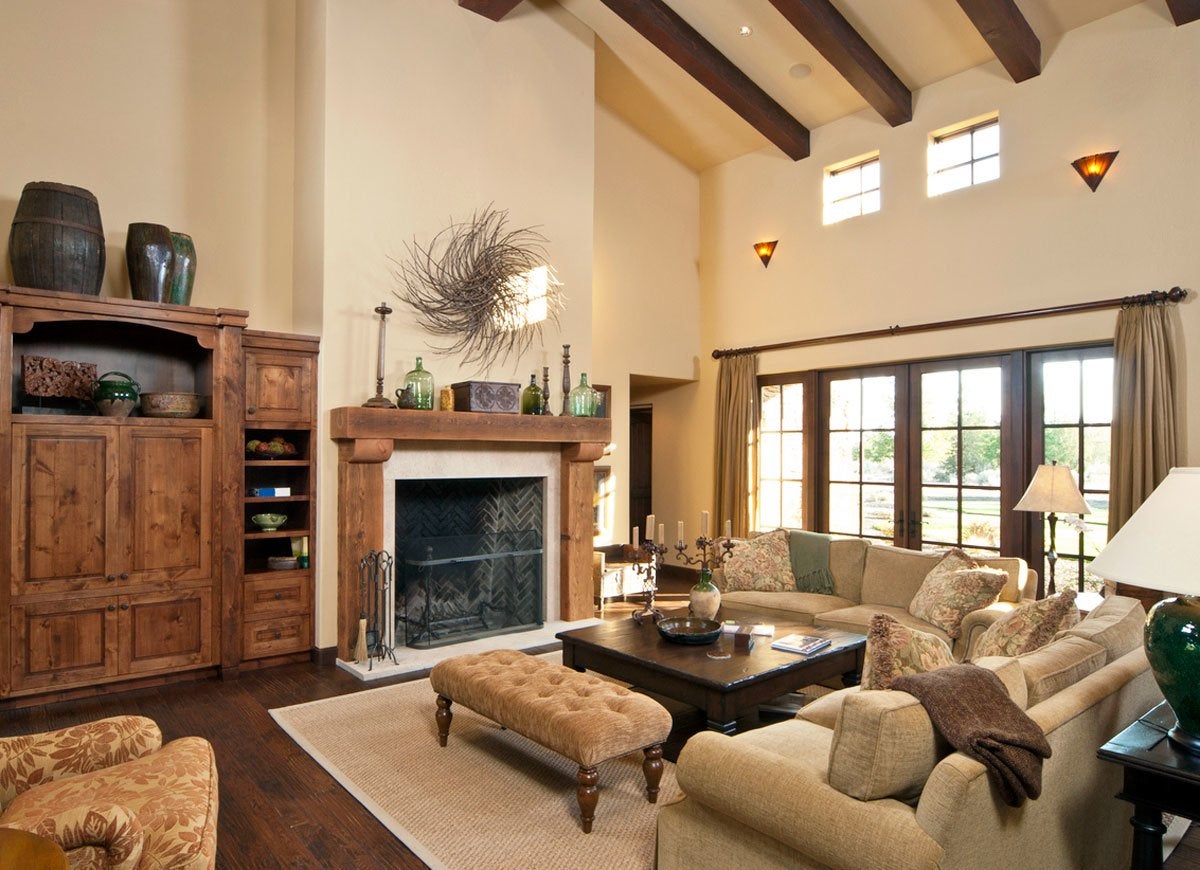
It’s a subtle change, but as the neutral of choice has shifted to gray, warmer beiges—ones with undertones of pink, yellow, or peach—are starting to feel out of date. If gray is too cool for you, consider a greige (that’s gray plus beige), which is a light neutral with both cool (gray) and warm (brown) notes.
RELATED: The Best Greige Paint Colors for a Warm, Welcoming Home
Popcorn Ceilings

This nubby treatment gave ceilings everywhere a textured look through the mid-20th century, but made it more difficult than it should be for anyone trying to clean cobwebs from the upper corners of a room. Despite their unpopularity, popcorn ceilings are still around today in lots of homes because removal of these ceilings, some of which contain asbestos, can be expensive, messy, and potentially detrimental to health.
Pastel Fixtures
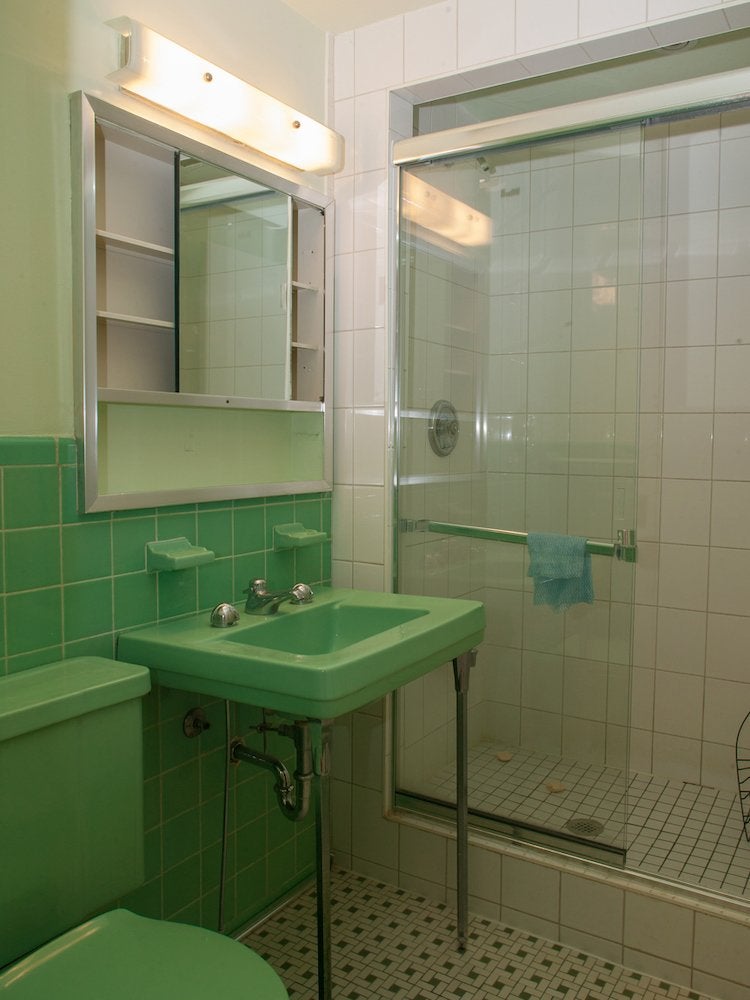
Pastel pink and mint green toilets, tubs, sinks, and more were popular in the 1950s. If they’re still in your home, it’s a clear sign that no one’s remodeled since then. Before you renovate, be aware that these throwback materials are still popular among a certain set—why not try to find your old porcelain a new home?
Laminate Countertops
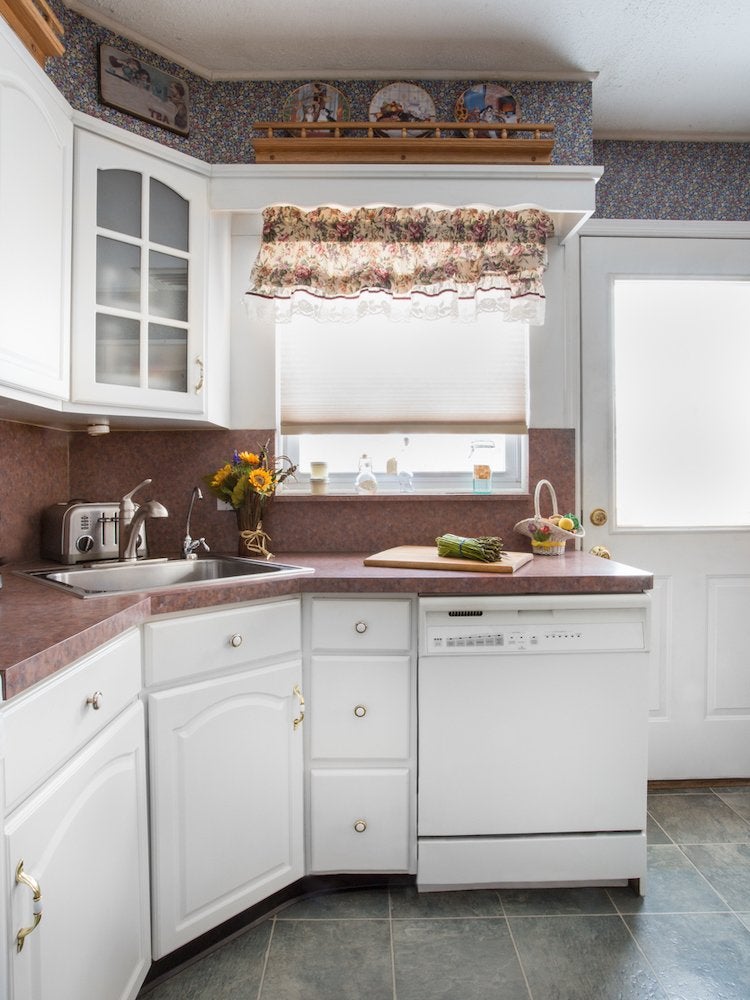
Popular in the 1960s and ’70s for their durability and low price point, laminate countertops, particularly Formica, were a mark of pride. Though this countertop material is still a good, affordable option, it’s no longer as popular as natural or engineered stone countertops like marble, granite, and quartz.
RELATED: 10 Ways You’re Accidentally Ruining Your Countertops
Shiny Gold Fixtures

In the early 1990s, shiny brass faucets, light fixtures, and hardware were the norm, beloved for their flashy sheen. Though gold-toned hardware is on its way back into style, these newer designs are more muted in tone and feature rounded or geometrically inspired silhouettes instead of the clunky shapes of 20 years ago.
RELATED: Inspired by the Olympics 2024: 10 Gold Medal-Worthy Accents We Love for Kitchens and Baths
Dark Wood Paneling
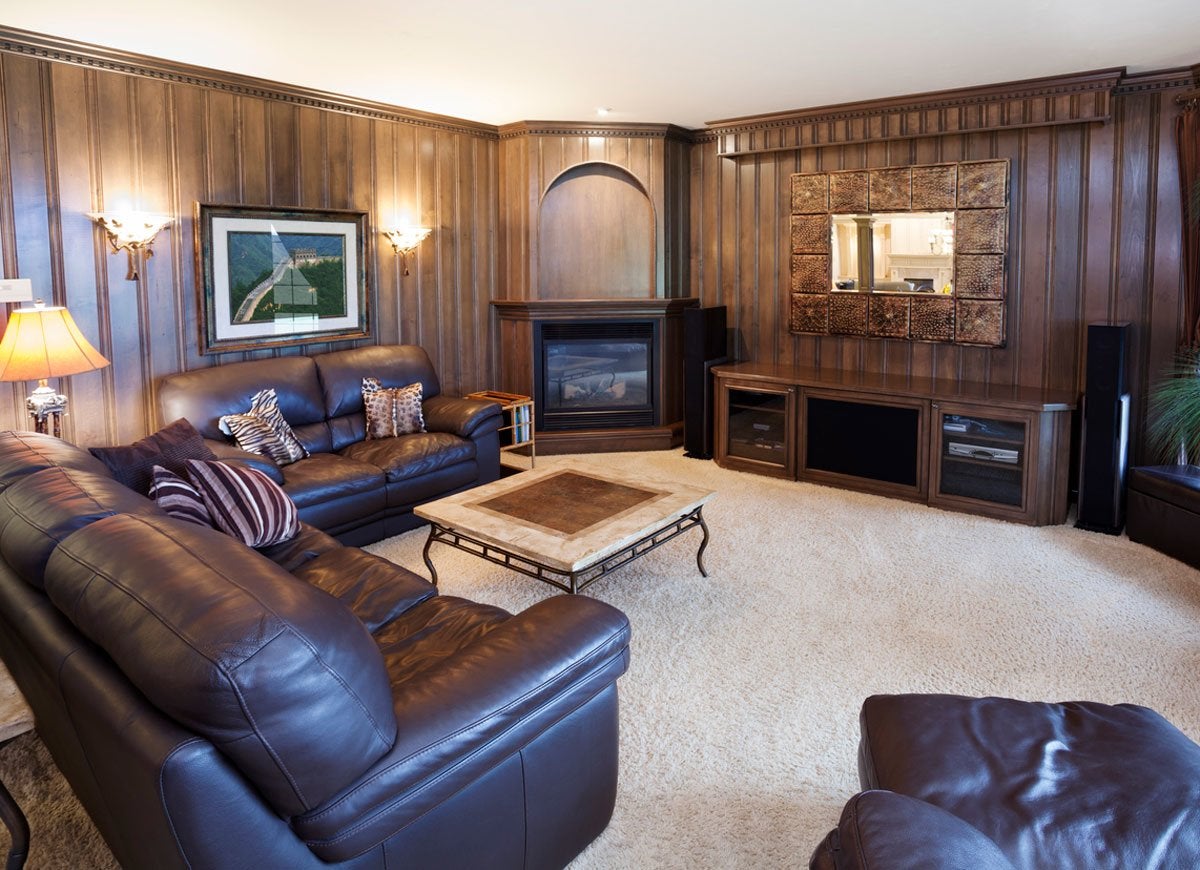
Dark wood paneling was super popular in the 1960s and ’70s. Today, while many homeowners have phased out dark and dreary walls in favor of neutral or brightly painted drywall, plenty of other homes still have 20th-century paneling in place. If your home still sports real wood paneling, consider bleaching or painting over it to update it. If, however, the walls are covered by sheets of faux-wood paneling, pull them off now!
RELATED: How to Paint Wood Wall Paneling
Oversize Media Cabinets

Zillow Digs home in Tucson, AZ
Gone are the days when your TV was as deep as your sofa: In this era of flat-screen televisions that mount almost flush to the wall, no one needs a big ol’ cabinet to hold their technology. Pull that dinosaur out, already!
Chintz Wallpaper

A 19th-century staple that enjoyed a revival in the late 1980s and early ’90s, this fussy floral wallpaper feels out of date today. Done right, it can add vintage flair to an eclectic space. Done wrong, it just looks like Grandma decorated your space (no offense, Gram).
RELATED: I Transformed My Living Space Without Picking Up a Paint Brush Thanks to This Easy-to-Use Product
Millennial Pink

This soft-hued pink was all the rage just a few years ago. As with any trend, millennial pink became old news once the design world selected new colors to obsess over. Paint over this passé shade with a timeless neutral tone, and avoid purchasing pricier furniture pieces in the color—save the millennial pink for decorative accents that you can easily replace.
Vertical Blinds

They’re annoying to clean and even more irritating if you have pets, who seem to continuously dislodge the delicate blinds and leave them strewn on the floor. Replace the aggravating blinds with more fashionable window coverings, like airy curtains or farmhouse shutters. Not sure about the best fit for your windows? Many home decor stores now offer free in-home window treatment consultations.
RELATED: Lose the Drapes: 17 Ways to Dress a Window Without Curtains
Word Art and Wall Decals

Pop into a home decor shop or gift store and you no doubt will spot word art. Farmhouse style made simple phrases like “home,” “eat,” and “live, love, laugh,” emblazoned on wood signs the coolest form of wall decor. While the rustic aesthetic remains as popular as ever, its kitschy decor and decals have faded into the realm of basic platitudes.
Tile Countertops

Once popular in the ’70s, tile counters are a sure sign that your home needs an update. This type of countertop isn’t just visually unappealing, it’s also incredibly tough to clean properly—yet another reason to swap out your old countertops for an easier to maintain surface.
Linoleum Floors

This cheap material is long-lasting, but easily dents and discolors. Update your old linoleum floors on a budget by opting for laminate flooring, which can be laid over existing linoleum floors.
RELATED: How to Remove Linoleum Flooring
Wallpaper Borders

Wallpaper borders were a staple in the ’90s, mainly used as trim for the top or middle of the walls. A better way to jazz up your walls these days is to opt for a bright accent wall, stylish wallpapers, or crown molding.
RELATED: The 16 Best Accent Wall Colors
Pine Furniture

At one time, pine was the preferred wood for furniture, and it was hard to enter a room in the house and not spot pine tables, chairs, hutches or chests. While a little pine is okay, a lot of it is overwhelming and a little too “log cabin” for most homes. Opt for furniture in other attractive types of wood, such as teak, walnut, or acacia.
RELATED: 10 Ways to Renew Old Wood Furniture
Stenciling and Sponging

Decorating walls by hand was big in the ’90s. Adding texture or dimension with sponging was a tedious task, but it left homeowners with a look that was coveted at the time. Stenciling, too, was a hobby that left many ’90s-era walls with painted-on patterns. Grab a can of paint and cover up those outdated faux finishes and themed stencils.
Floral Accents

Rooms that are layered in floral motifs are straight out of the ’80s (remember Pretty in Pink?). To bring your otherwise monochromatic living room into the 21st century, brighten it with a few boldly patterned floral pillows. Mix and match solid and floral accents, too, to keep your living room from looking like your grandma’s parlor.
Heavy Window Treatments

Bulky curtains and heavy valances are things of the past, and for good reason. Heavy window treatments can overtake your space and make it feel claustrophobic. What’s more, they require a ton of upkeep (and trips to the dry cleaner) to look their best. The greater the surface area, the more dust chunky curtains will attract.
Avocado Green Appliances

MitchellHaindfeld via Flickr.com
The first kitchen appliances were white. The 1950s brought a rainbow of pastel fridges and stoves, and the late 1960s brought even bolder shades, most infamously avocado green, which felt like it was everywhere in the ’70s. If you have an avocado green oven in your kitchen today, it’s likely that your kitchen appliances haven’t been updated in almost 50 years. Kudos to you for keeping it in good condition for so long and everything, but it’s probably time for an update.
Bathroom Carpeting

In the 1960s and ’70s, carpeting started to show up in bathrooms, where it brought warmth underfoot and an overall sense of luxury. Homeowners soon realized that it’s also a breeding ground for mold and mildew, and it was notoriously hard to keep clean in such a high-traffic spot. If you still have carpeting in the bathroom, it’s time to swap it out for a more forgiving, hygienic surface like ceramic or porcelain tile, or natural stone. While you’re at it, toss that fuzzy toilet seat cover and contour rug!
RELATED: 9 Bathroom Flooring Ideas That Are as Durable as They Are Stylish
Matching Furniture Sets

Matching dining room, living room, or bedroom sets, those staples of 1980s game show prizes, can easily overwhelm a space. Their uniform look, conservative styling, and visual heft are out of place in today’s pared-down, eclectic interiors. Find a new home for that old farmhouse-style set or better yet, keep the table or hutch and swap out the rest with a few complementary pieces that add interest to the room, and better reflect your tastes.
RELATED: Editors’ Picks: 8 Favorite Etsy Stores for One-of-a-Kind Furniture
In-Wall Tech From the Last Millennium

jcsullivan24 via flickr.com
Does your house still have an in-wall intercom system, radio, or analog thermostat? This antiquated tech screams “dated!” and needs to be removed or replaced. Through-the-wall air conditioners also carry a whiff of the past, although the benefit of cool air usually outweighs their aesthetic shortcomings. That said, while central air may not be an option for most of us, it’s worth considering upgrading to a quieter, more efficient mini-split system.
Traditional-Style Ceiling Fans

Ceiling fans are effective, energy-efficient solutions for improving airflow and keeping the house cooler, but the traditional models with wood-grain blades and frilly glass bell-shaped shades are firmly rooted in the ’80s and should be replaced. Today’s ceiling fans are more streamlined and subtle, providing all the benefits of a fan without the fanfare.

Everything You Need for a Lush and Healthy Lawn
Keeping your grass green and your plants thriving doesn’t just take a green thumb—it starts with the right tools and supplies.
